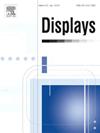Blind DIBR-synthesized view quality assessment by integrating local geometry and global structure analysis
IF 3.7
2区 工程技术
Q1 COMPUTER SCIENCE, HARDWARE & ARCHITECTURE
引用次数: 0
Abstract
The realization of free viewpoint videos (FVV) relies heavily on depth-image-based-rendering (DIBR) technology, but the imperfections of DIBR usually lead to local geometric distortions that significantly impact user experience. Therefore, it is crucial to develop a specialized image quality assessment (IQA) model for DIBR-synthesized views. To address this, this paper leverages local geometry and global structure analysis for DIBR-synthesized IQA (LGGS-SIQA). Specifically, in the local geometry-aware feature extraction module, the proposed method introduces an auxiliary task that converts the score learning task into a distortion classification task, aiming to simplify score sample expansion while effectively locating local geometric distortion regions. Based on this, different types of DIBR-synthesized distortions are further detected and weighted to obtain local geometric features. In the global structure-aware feature extraction module, as DIBR-synthesized distortions are mainly concentrated at object edges, the proposed method designs a strategy to extract key structures globally. Statistical analysis of these regions is performed to obtain robust global structural features. Finally, these two types of features are fused and regressed to obtain the final quality score. Experimental results on public benchmark databases show that the proposed LGGS-SIQA method outperforms existing manually extracted-based and deep learning-based IQA methods. Besides, feature ablation experiments validate the effectiveness of the core components of the proposed LGGS-SIQA method.
结合局部几何和全局结构分析的盲dibr合成视图质量评价
自由视点视频(FVV)的实现很大程度上依赖于深度图像渲染(deep -image-based rendering, DIBR)技术,但DIBR技术的不完善通常会导致局部几何扭曲,严重影响用户体验。因此,为dibr合成视图开发专门的图像质量评估(IQA)模型至关重要。为了解决这个问题,本文对dibr合成的IQA (LGGS-SIQA)进行了局部几何和全局结构分析。具体而言,在局部几何感知特征提取模块中,该方法引入了辅助任务,将分数学习任务转化为失真分类任务,旨在简化分数样本扩展,同时有效定位局部几何失真区域。在此基础上,进一步检测不同类型的dibr合成畸变并进行加权,得到局部几何特征。在全局结构感知特征提取模块中,由于dibr合成的畸变主要集中在目标边缘,该方法设计了全局提取关键结构的策略。对这些区域进行统计分析,以获得稳健的全局结构特征。最后,对这两类特征进行融合和回归,得到最终的质量分数。在公共基准数据库上的实验结果表明,LGGS-SIQA方法优于现有的基于人工提取和深度学习的IQA方法。此外,特征烧蚀实验验证了LGGS-SIQA方法核心部件的有效性。
本文章由计算机程序翻译,如有差异,请以英文原文为准。
求助全文
约1分钟内获得全文
求助全文
来源期刊

Displays
工程技术-工程:电子与电气
CiteScore
4.60
自引率
25.60%
发文量
138
审稿时长
92 days
期刊介绍:
Displays is the international journal covering the research and development of display technology, its effective presentation and perception of information, and applications and systems including display-human interface.
Technical papers on practical developments in Displays technology provide an effective channel to promote greater understanding and cross-fertilization across the diverse disciplines of the Displays community. Original research papers solving ergonomics issues at the display-human interface advance effective presentation of information. Tutorial papers covering fundamentals intended for display technologies and human factor engineers new to the field will also occasionally featured.
 求助内容:
求助内容: 应助结果提醒方式:
应助结果提醒方式:


